Butterflies and moths are well represented in the Algarve, along with several interesting dragonflies and grasshoppers plus countless beetles. Spiders and scorpions are among the other abundant arthropods in this lovely part of southern Portugal.
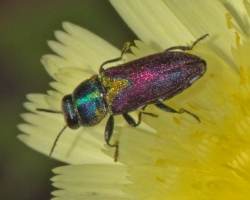 |
Anthaxia scutellaris, a Jewel Beetle
This iridescent wood-boring beetle, a member of the family Buprestidae, is found throughout the Algarve as well as in many other Mediterranean countries including Albania, Croatia, France, Italy, Greece, Portugal and Spain. This beetle is also common in many part of North Africa. The adult beetles, which are 5-6mm long, are likely to be see between April and July. They are most commonly found on various kinds of daisies (family Asteraceae), but they can also be seen occasionally on umbellifers (family Apiaceae). |
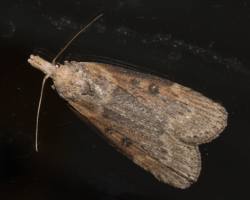 |
Aphomia zelleri
This snout moth, a member of the family Pyralidae, has a wingspan of 19-27mm. Its larvae feed on Marram Grass and a few other kinds of grasses that occur in coastal sand-dune systems.
The specimen shown here was found close to sandy coastal clifftops at Monte Carvoiero, in the Algarve region of southern Portugal. |
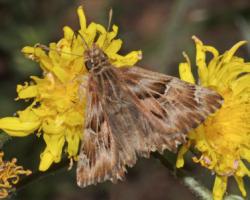 |
False Mallow Skipper Carcharodus tripolinus
Macroscopically almost impossible to distinguish from the Mallow Skipper Carcharodus alceae, the False Mallow Skipper has a restricted range. It is found along the Algarve coast of southern Portugal and on Atlantic coastal regions of Spain and northern Africa. Its larval food plant is Common Mallow Malva sylvestris.
The specimen shown here was seen near Querença, in the Loulé district of the Algarve. |
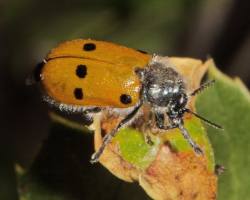 |
Clytra quadripunctata
This leaf beetle of the family Chrysomelidae was seen near the village of Paderne, in the Loulé district of the Algarve. Its scientific name refers to four black spots, although it seems that not all specimens adhere strictly to this quota.
It is widely reported that these beetles drop their eggs from vegetation above wood ant nests, where they are picked up by passing ants which carry them into the nest are look after them. The food plants of this beetle are varied and include a range of trees and shrubs as well as Cock's-foot grass and Bracken. |
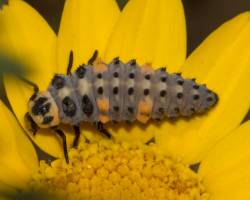 |
Larva of the Seven-spot Ladybird Cocinella septipunctata
Insects that go through a complete metamorphosis often have larvae very different in form and colouring from the mature adults. This is certainly so with the Seven-spot Ladybird, whose adult is bright red with black spots.
The Seven-spot Ladybird, a member of the family Coccinellidae, is the most common of Europe's ladybird species, and it can be seen throughout the Algarve.
Aphids (sometimes referred to as greenfly) are the staple diet of beetles of this kind - indeed, the Seven-spot Ladybird was introduced to North America in order to control aphids, and it now breeds there very successfully. (In the USA this insect is commonly referred to as the Seven-spotted Ladybug.) |
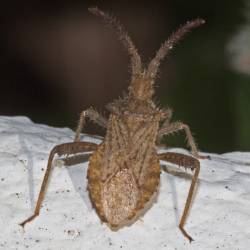 |
Denticulate Leatherbug Coriomeris denticultus
This bristly squashbug, a member of the family Coreidae, was seen in Monte Carvoiero, in the Algarve region of southern Portugal. It feeds on Black Medick Medicago lupulina and various other plants of the family Fabaceae (the pea family). Adults are typically 7 - 9mm in length. |
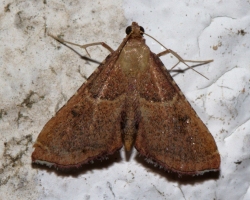 |
Rosy Tabby Moth Endotricha flammealis
The Rosy Tabby, a member of the family Pyralidae, has a wingspan of 18-23mm and is found in many parts of central and southern Europe, including the Algarve. Its larval foodplants are varied and initially include Common Agrimony Agrimonia eupatoria, but older caterpillars feed largely on dead leaves.
At rest this moth's posture is distinctive: it sits upon raised forelegs so that the head and thorax are elevated at a steepish angle. |
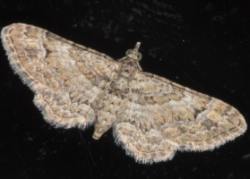 |
Double-striped Pug Moth Gymnoscelis rufifasciata
This member of the family Geometridae, which has a wingspan of 15-19mm, has a wide range of larval foodplants. The Double-striped Pug is common throughout most of Europe including the Algarve region of southern Portugal.
The specimen shown her was photographed at Monte Carvoeiro, on the south coast of the Algarve. |
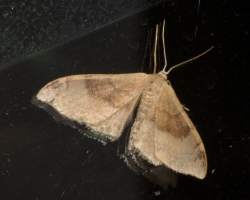 |
Portland Ribbon Wave Moth Idaea degeneraria
The Portland Ribbon Wave, a member of the family Geometridae, has a wingspan of 26-31mm. In captivity the larvae will eat dandelions and knotgrass (docks and their relatives), but it is unclear whether there are other preferred larval foodplants in the wild.
The specimen shown here was seen at Monte Carvoeiro, on the south coast of the Algarve. |
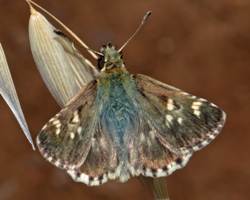 |
Sage Skipper Muschampia proto
A member of the family Hesperiidae, the Sage Skipper has a wingspan of 22-26mm. It occurs in southern Europe (including the Algarve) and north Africa. As the common name suggesrs, the larvae feed on various kinds of sage (Phlomis species).
The Sage Skipper shown here was photographed near Querença, in the Loulé district of the Algarve. |
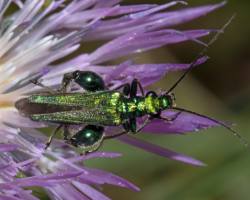 |
Swollen-thighed Beetle Oedemera nobilis
Also known as the Thick-legged Flower Beetle and the Fat-legged Beetle, Oedemera nobilis is a member of the family Oemeridae. Only the males have the distinctive swollen thighs on their hindlegs. Its larval food plants include certain thistles and Spanish Broom, while the adult beetles feed on pollen and nectar of a wide range of plants.
The longitudinal range of this beetle stretches from northern England down to the north of Africa and includes the Algarve region of Portugal. (The male shown here was found near Boca do Ria.)
|
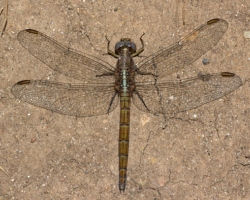 |
Epaulet Skimmer Orthetrum chrysostigma
Essentially an African dragonfly species, the Epaulet Skimmer is found in Europe only in the extreme south, which of course includes the Algarve. Look out for Epaulet Skimmers on backwaters or slow-flowing sections of rivers.
This attractive member of the family Libellulidae is not easy to identify in the field, but one of its distinguishing features is the noticeably waisted form of the male's abdomen. (A female is shown here.) Most noticeably when they are young, both the male and the female have whitish patches on each side of the thorax, and it is from this feature that the common name is derived. The scientific name is a reference to the golden colour of the pterostigma (the coloured patch on the outer leading edges of both pairs of wings). |
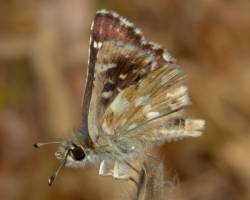 |
Red-underwing Skipper Spialia sertorius
A member of the family Hesperiidae, the Red-underwing Skipper has a wingspan of 22-26mm. Its larval foodplants include Salad Burnet Sanguisorba minor and various kinds of cinquefoil (Potentilla species).
This butterfly is found in many parts on central and southern Europe, including the Algarve, as well as northern Africa.
The Red-underwing Skipper shown here was photographed near Querença, in the Loulé district of the Algarve. |
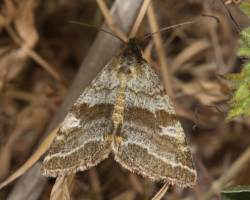 |
Goldwing Synthymia fixa
The Goldwing, a member of the family Noctuidae, is found in southern Europe (including the Algarve region of Portugal) and northern Africa. Its wingspam is 37-40mm. The common name refers to the gold colouring of the hindwings, not normally visible when the moth is at rest.
The caterpillars of this moth are known to feed on bitumen vetch Psoralea bituminosa.
The Goldwing shown here was photographed at Benegil, on the Algarve's southern coast. |
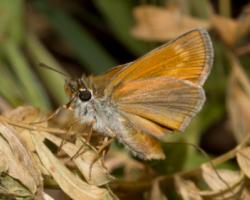 |
Lulworth Skipper Thymelicus acteon
These little butterflies (wingspan 24-28mm, the females slightly larger than the males) were originally described based on specimens collected near Lulworth Cove on the Dorset coast of southerrn England. In Britain they are largely restricted to the south coast of England and are rare sights - as indeed they are in other northern European countries. The Lulworth Skipper is rather more common in central and southern Europe, including the Algarve region of Portugal.
Females lay their eggs of the flower sheaths of Tor-grass Brachypodium pinnatum, which is the larval foodplant of this species. |
For details of some the best sites for butterflies, moths, beetles and other arthropods, see our Nature Reserves/Parks and Wildlife Walks sections; however, it's worth mentioning here that in springtime any disturbed wasteland soon becomes a wonderful wildflower garden, so that butterflies can be seen in urban settings throughout the Algarve as well as in the countryside.
The table below lists a small selection of many butterflies that you can expect to see in the Algarve. For excellent pictures and detailed information of when and where some of the Algarve's most colourful insects are most likely to be seen, it's well worth getting a copy of Algarve Wildlife, the natural year. Author Clive Viney and photographer Ray Tipper are very experienced naturalists; they have lived in the Algarve and studied its wildlife for many years.
In the tables below, Occurrence * = Very Rare; ** = Scarce; *** = Common; **** = Very Common; ***** = Abundant.